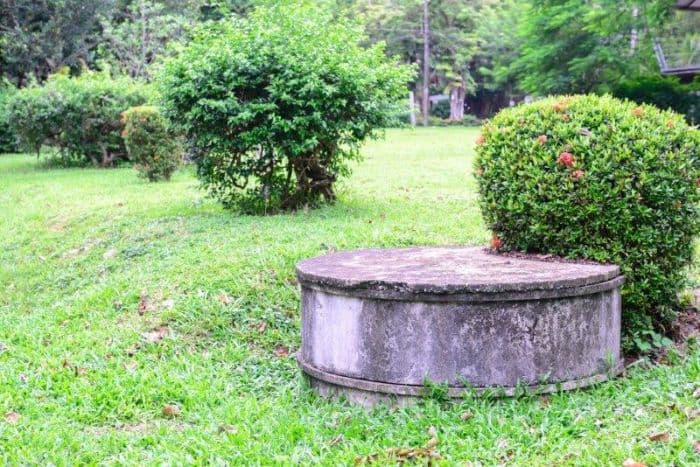Everything to Know About Advanced Treatment Systems
By Editorial Team
Updated on August 30, 2024

This article will focus on installing advanced septic systems in Canada, namely in Quebec. Why opt for such eco-friendly, efficient wastewater management solutions? What are the advantages of advanced systems and what options are available? What are the key system installation and maintenance steps? Whether you’re installing a new system or updating an existing one, this guide details all the necessary information you need to make an informed decision and ensure a sustainable system.
What Is an Advanced Septic Treatment System?
A conventional septic system collects drain and toilet wastewater. It retains solids and residue inside the septic tank while channelling liquids toward its drain field. In the drain or leach field, bacteria break down the organic waste matter, allowing treated water to seep into the soil and groundwater.
On the other hand, an advanced septic system receives the septic tank’s wastewater and reduces its levels of organic matter, suspended solids, pathogens, and in some cases, nutrients like phosphorus or nitrogen. Once treated, water is released downstream, where it can seep back into the soil, trench, or stream.
The main difference between conventional and advanced septic systems lies in their respective treatment sites. When it comes to conventional systems, the drain field handles the majority of waste matter disposal. However, advanced systems carry out most of the treatment in a designated unit prior to releasing the wastewater into the environment.
Why Opt for an Advanced Septic System in Canada?

Source: Depositphotos
Design Advantages
Advanced septic tank treatment systems have a slew of advantages, such as:
Overcoming configuration issues associated with traditional systems
Removing a lot more bacteria and organic matter compared to traditional systems
Prolonging the leach field’s service life
Occupying significantly less space
Reducing nutrient production (phosphorus and nitrogen)
Disadvantages
Despite the many upsides of advanced septic systems, there are certain drawbacks to consider. Given the different types of systems marketed, here’s a general overview of the systems' disadvantages:
More costly than basic systems
Require mandatory maintenance
Significant overall ecological footprint
Need a power source to operate pumps (depending on type)
Mechanical parts may malfunction or fall into disrepair (depending on type)
How to Carry Out an Advanced Septic System Installation
Necessary Material and Equipment
First, decide on a system. As mentioned, there are different options marketed, but luckily, they can be grouped into two general categories: filtering mediums and aerobic treatment units (ATUs).
Filtering mediums: Domestic wastewater flows through a filter that collects and eliminates contaminants. Common filtration materials include sand as well as synthetic materials, such as foam, fabric, or textile.
Aerobic treatment unit (ATU): Wastewater is pumped with oxygen using an aerator or diffuser. Doing so fosters aerobic bacterial growth, which requires oxygen to break down suspended solids and other contaminants found in the wastewater.
Here are some of the advanced treatment systems approved in Quebec:
Bionest wastewater treatment system: Uses a technology that reproduces, in rapid succession, the natural purification that occurs in the soil. The system’s objective is to remove harmful residue, for both health and environmental reasons, from wastewater, before it's released in the drain field or another disposal system.
Ecoflo green septic system: This system, designed with coco filters (coconut husk fragments), treats wastewater according to public health and environmental standards.
Hydro-Kinetic: Used for residential dwellings, cottages, and small businesses. Several tanks (number varies based on the chosen model) are lined up until the wastewater is treated, wholly or partially, depending on the number of tanks.
System O (Enviro-Septic): This eco-friendly, cutting-edge system is a far cry from traditional septic tanks.
No matter the system of your choosing, conventional septic systems are made up of four main parts: a pipe that channels domestic wastewater, a septic tank, a pipe connecting the tank to the drain field, and the drain field itself.
On the other hand, an advanced septic system is typically built similarly, yet has one or more treatment systems between the septic tank and the dedicated treated wastewater disposal field.
Biofilter's Home Septic Tank System Installation Steps
Given that the systems available are so different, the installation process will differ based on your choice. To make it easier, we’ll use Ecoflo’s fibreglass, open-bottom biofilter as an example so you can have a general idea as to what to expect.
Gather necessary components: Fibreglass shell, owner documents, plastic tie-wraps, insulating board, lid, tipping bucket, distribution plates, sampling device, central support, and filtering media.
Prepare absorption bed and install central support: Make the absorption bed with clean crushed stone (15–60 mm, 20 mm preferably), ensuring the bed is at least 200 mm (8”) thick. Then, position the sampling device correctly, level the central support, and keep away from trees.
Position and level the shell: Place the shell atop the central support, ensuring that both parts are level and embedded into the crushed stone.
Install geotextile and initial backfill: Lay the geotextile fabric around the shell, carefully backfilling without overloading or damaging the shell. Use a sandy material devoid of organic matter.
Connect water supply pipe: Connect the septic tank’s water supply pipe to Ecoflo’s Biofilter, ensuring there’s a downward slope.
Final backfill and filtering media installation: Carefully complete the backfill using sandy material, ensuring the lids are above the landscaped lot. Fill the Biofilter with filtering media without compacting.
Install distribution plates: Place the distribution plates with the arrows pointing toward the shell’s extremities, secured with plastic tie-wraps.
Install tipping bucket: Secure the tipping bucket to the central support, ensuring it can move back and forth freely.
System start-up and warranty seals: Check the system’s class and install the insulating board with fasteners. Seal the lid using the provided wraps and lag screws.
How Much Does a Septic Tank Cost?
Here are the four main fees to consider when planning a septic system installation:
Steps | Cost |
Soil testing | $600–$2,000 |
Installation | $10,000–$45,000 |
Inspection | $400–$500 |
Maintenance | $150–$700 |
Said fees may vary on account of several factors, such as the system’s size and installation complexity.
For more information, check out our article How Much Does a Septic Tank Cost?
How to Maintain an Advanced Septic System and Drain Field

Source: Wikimedia Commons
In terms of advanced septic system care, leaving such a task to professionals is best. Given the system’s complexity and potential impact on the environment if an error is committed, consulting with experts is paramount. However, there are steps you can take to help prevent use-related damage or problems.
Septic Tank Maintenance Methods
Reduce your water use by installing low-flow faucets, shower heads, and toilets, and repair leaks.
Use septic tank-friendly toilet paper and tissues.
Don’t overload your septic tank; avoid pouring grease or food scraps into the sewer line.
Avoid using your kitchen sink’s garbage disposal.
Don’t dispose of the following items in your tank: fabric, bleach, paint, aerosols, glues, solvents, cigarette butts, medication, cosmetics, clog remover, antibacterial soaps, and feminine hygiene products.
Hire a company specializing in septic tank care and maintenance; said professionals have the right equipment and offer inspection and customer services.
To learn more, check out our article How to Maintain a Septic Tank.
Common Repairs
Common and necessary advanced septic system repairs include:
Pump replacement: Pumps wear out over time and need to be replaced to ensure proper wastewater flow.
Aerator repairs: The aeration chamber can break down, requiring repairs or replacement to ensure an effective treatment.
Control panel issues: The septic control panel can encounter electrical or operational issues, requiring repairs or recalibration.
Clogged filters: Filters can clog with solids or debris, requiring cleaning or replacement to maintain the system’s efficiency.
Drain field repairs: Problems like soil compaction, invasive roots, or a clogged drain field can require excavation and repairs.
Pipeline repairs: Leaky or damaged pipes can lead to system failures, requiring replacement or repairs.
Sludge removal: Regular sludge removal can be necessary if the build-up exceeds acceptable levels, requiring pumping services.
Leak issues: Should effluent rise to the surface, it’s likely because there’s a problem, requiring professional assessment and repairs.
When Should You Install an Advanced Septic System?
Advanced septic systems are typically used on properties with:
Limited space for a traditional leach field
Shallow soil that can’t effectively absorb wastewater
Waterproof soil or bedrock, preventing wastewater seepage
There are also required in vulnerable environments mandating:
Additional wastewater treatment
Strict local environmental regulations
When Is the Best Time to Install a System?
Early fall is the best time for optimal system installation or replacement. During said time of year, weather patterns are typically more predictable, allowing technicians to work efficiently, without being interrupted by severe storms. Moreover, dryer soil conditions post-summer rainfalls streamline quick installations. Warmer weather makes excavation easier, preventing delays caused by frozen grounds during wintertime. Planning your installation for early fall can help ensure a faster and streamlined process.
Telltale Signs Your Septic System Is in Dire Need of Repair
If you’re planning on updating or replacing your septic system with a newer, upgraded model, here are some telltale signs to act now:
System’s age: Septic systems typically last 40 years or so, but older systems may need to be upgraded to on-site advanced wastewater treatment solutions.
Increased pumping needs: If you need to have your system pumped more often than necessary to ensure its proper functioning, this may be indicative of a necessary upgrade.
Slow drainage: Visibly slow drainage in sinks or tubs can be indicative of a build-up in the system.
Stagnant water: Stagnant water in a backyard can be indicative of a bigger problem, one that's more likely related to the drain field. While it’s not always a sign that your entire system needs replacement, it can be a telltale sign of a problem requiring particular attention.
Potential issues with drain field: Stagnant water can be a telltale sign of a clogged or damaged drain field, requiring professional assessment.
Professional assessment: Septic system professional service providers will assess your system’s efficiency and recommend the necessary upgrades.
System size: Septic systems are designed based on the number of bedrooms and bathrooms in a home. Adding rooms can necessitate a bigger system.
Increased water use: More occupants can test the septic system’s capacity, leading to drainage issues and more frequent pumpings.
Potential drainage issues: An undersized system can lead to stagnant water and inefficient breakdown of liquids, affecting the system’s overall performance.
Additional Helpful Information
Chapter Q-2, r. 22—Regulation Respecting Waste Water Disposal Systems for Isolated Dwellings
The Regulation respecting waste water disposal systems for isolated dwellings pertains to the disposal and treatment of wastewater discharged from dwellings with a maximum of 6 bedrooms and from buildings and premises producing a total daily domestic wastewater flow of fewer than 3,240 litres. These various structures shouldn't be connected to any of the municipal sewer systems or combined sewers.
As of August 12, 1981, the purpose of this regulation is to, pure and simple, prohibit "waste" water discharge (in the broadest sense of the term: toilets, household water, etc.) into the environment, unless it's been properly treated. Otherwise, the Environmental Quality Act qualifies it as a contaminant.
Therefore, a permit issued by the relevant municipality is required for any person wishing to build an isolated residence or a building similar to those mentioned above. The same applies if a person wishes to convert a space, increase its capacity, change its use, carry out construction, or change a water treatment system within it. The application must include a set of documents listed in section 4.1 of the by-law and, to do so successfully, it must include, among other things, a characterization study of the site and the receiving land, carried out by a qualified individual in the matter (in other words, an expert).
Municipal approval rests on the compliance of the treatment and disposal system. To be approved, the by-law provides the criteria—technical standards and performance standards—that must be met for isolated dwelling treatment systems.
Amendments Made to the Regulation Since 2013
The Regulation was first amended on June 19, 2013, to conform to the penal measures introduced by the Environmental Quality Act amendments. The various offences have thus been categorized and the amount of the associated fines significantly increased.
On July 16, 2014, the Regulation was amended once again to make it consistent with the Water Withdrawal and Protection Regulation (WWPR), and these amendments came into effect on March 2, 2015.
The Regulation was last amended on March 29, 2017, and now includes four options for existing property owners of isolated dwellings until a tertiary treatment system is made available. Moreover, this amendment recognizes the process of sealing wells under the former Groundwater Catchment Regulation.
To know more about the regulation and how it was amended, visit the government’s webpage.
Advanced Tertiary Treatment Systems for Septic Tanks
Aptly named, a tertiary treatment system provides significantly better performance than an advanced secondary treatment system, including liquid waste (effluent) disinfection and/or phosphorus removal.
Disinfection ensures that effluent is discharged into a designated trench, while phosphorus removal ensures that the liquid waste is discharged directly into a watercourse or a trench located upstream from a lake. There are different tertiary treatment systems available in Quebec, one can choose between:
DpEC system: Disinfection and phosphorus removal tertiary treatment units. The first step is done by a self-cleaning, Electrocoagulation Unit, and the second (depending on the model) is done by UV radiation or via a sand filter kit.
UV water purification system: The effluent is disinfected by a UV light, which can seep into the nucleus of bacteria, and then effectively destroy it.
Passive disinfection filter (FDi): A tertiary treatment system’s efficiency relies on filtering sand combined with a biofilter, for optimal wastewater disinfection.
Key Facts About Advanced Septic Systems
To sum it up, installing an advanced septic system in Quebec (and anywhere in Canada for that matter) is subject to strict regulations, ensuring environmental standards are met. Advanced systems, such as biofilters and aerobic treatment units, provide significant advantages, including improved pollutant reduction and more efficient use of space.
However, they do incur significant costs and regular maintenance. To guarantee optimal performance, choosing the right system is crucial, so is following the manufacturer’s installation steps, and hiring professional maintenance service providers. Should your current system exhibit the telltale signs of system malfunctions or obsolescence, consider upgrading to an advanced solution to ensure proper and eco-friendly wastewater management.
Looking for something else?
Related articles
The latest industry news, interviews, technologies, and resources.

Editorial Team
•16 Sep 2024
Are you hoping to build a bigenerational home to take care of your elderly parents? Albeit it’s only logical to believe that one will be able to benefit from this cohabitating situation, it’s, nonetheless, a rather large-scale project.

Editorial Team
•07 Nov 2023
Would you say your backyard is missing a little something, or just a cozy spot to lounge with your family or friends, making memories, during summertime? Have you thought about a concrete block fire pit? If this feature is the missing piece to your happiness, you can now rest easy. In this article, we’re taking a deep dive into everything about concrete block fire pits, and how you can DIY one for your backyard.

Editorial Team
•07 Nov 2023
Is the exterior siding of your brick house starting to look a little worn? If the idea of bringing it back to its former beauty by restoring it has crossed your mind, you may have considered painting as an option.

Editorial Team
•07 Nov 2024
Unless it’s in terrible condition, the interior staircase is rarely a top priority in home renovations. After all, its main function is to simply lead us from point A to point B. But what if your staircase could do more than just serve as a passageway? Can it be both functional and a beautiful design element? If you're thinking about renovating your staircase, you might wonder: Where do you begin? Do you need to replace the entire structure, or can a few targeted improvements transform the space? In this article, we’ll explore several renovation projects—both small and large—that will help you restore, remodel, or enhance your interior staircase.

Cynthia Pigeon
•08 Oct 2025
Welding is a creative trade, the likes of which few blue-collar trades still encompass. Skilled welders can work in any environment with a variety of materials and techniques. From skills to salary to job opportunities, learn everything there is to know about welding.